Comprehensive Report: Contract and Negligence Legal Aspects
VerifiedAdded on 2019/12/03
|8
|2863
|152
Report
AI Summary
This report delves into the legal aspects of contract and negligence, providing a comprehensive analysis of various scenarios. It begins by outlining the essential elements of a valid contract, including offer, acceptance, and consideration, and differentiates between various contract types such as bilateral and unilateral, executed and executory. The report examines the validity of contracts in specific cases, differentiating between situations where valid contracts are formed and where they are not, based on the presence or absence of these essential elements. It then explores the significance of expressed and implied terms within contracts, explaining their meaning and impact. Furthermore, the report investigates the elements of the tort of negligence, contrasting liability in contract and tort, and referencing the landmark case of Donoghue v Stevenson. The report then discusses the liability of individuals and businesses, including the concept of vicarious liability, and how businesses can be held responsible for the actions of their employees.
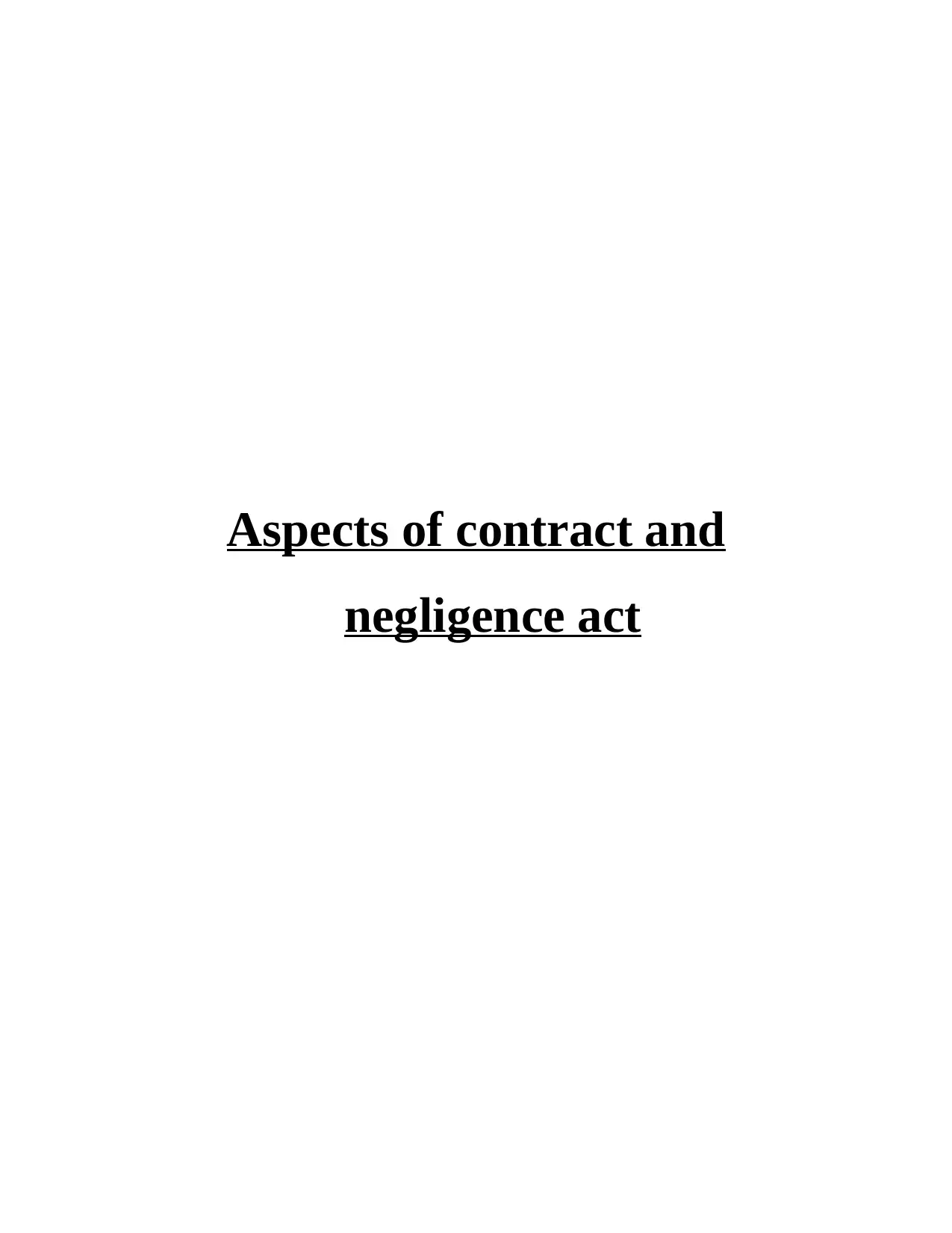
Aspects of contract and
negligence act
negligence act
Paraphrase This Document
Need a fresh take? Get an instant paraphrase of this document with our AI Paraphraser
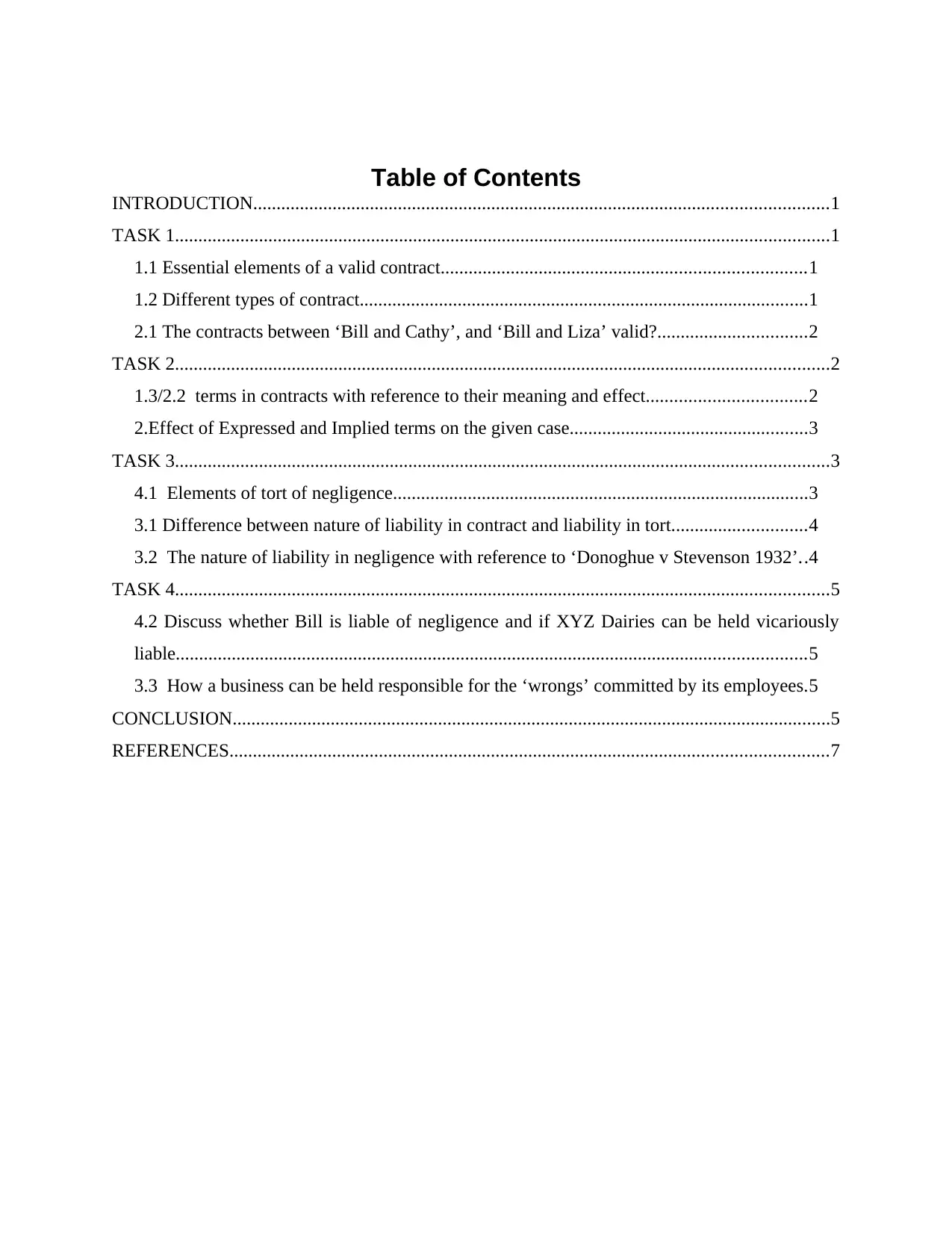
Table of Contents
INTRODUCTION...........................................................................................................................1
TASK 1............................................................................................................................................1
1.1 Essential elements of a valid contract..............................................................................1
1.2 Different types of contract................................................................................................1
2.1 The contracts between ‘Bill and Cathy’, and ‘Bill and Liza’ valid?................................2
TASK 2............................................................................................................................................2
1.3/2.2 terms in contracts with reference to their meaning and effect..................................2
2.Effect of Expressed and Implied terms on the given case...................................................3
TASK 3............................................................................................................................................3
4.1 Elements of tort of negligence.........................................................................................3
3.1 Difference between nature of liability in contract and liability in tort.............................4
3.2 The nature of liability in negligence with reference to ‘Donoghue v Stevenson 1932’..4
TASK 4............................................................................................................................................5
4.2 Discuss whether Bill is liable of negligence and if XYZ Dairies can be held vicariously
liable.......................................................................................................................................5
3.3 How a business can be held responsible for the ‘wrongs’ committed by its employees.5
CONCLUSION................................................................................................................................5
REFERENCES................................................................................................................................7
INTRODUCTION...........................................................................................................................1
TASK 1............................................................................................................................................1
1.1 Essential elements of a valid contract..............................................................................1
1.2 Different types of contract................................................................................................1
2.1 The contracts between ‘Bill and Cathy’, and ‘Bill and Liza’ valid?................................2
TASK 2............................................................................................................................................2
1.3/2.2 terms in contracts with reference to their meaning and effect..................................2
2.Effect of Expressed and Implied terms on the given case...................................................3
TASK 3............................................................................................................................................3
4.1 Elements of tort of negligence.........................................................................................3
3.1 Difference between nature of liability in contract and liability in tort.............................4
3.2 The nature of liability in negligence with reference to ‘Donoghue v Stevenson 1932’..4
TASK 4............................................................................................................................................5
4.2 Discuss whether Bill is liable of negligence and if XYZ Dairies can be held vicariously
liable.......................................................................................................................................5
3.3 How a business can be held responsible for the ‘wrongs’ committed by its employees.5
CONCLUSION................................................................................................................................5
REFERENCES................................................................................................................................7
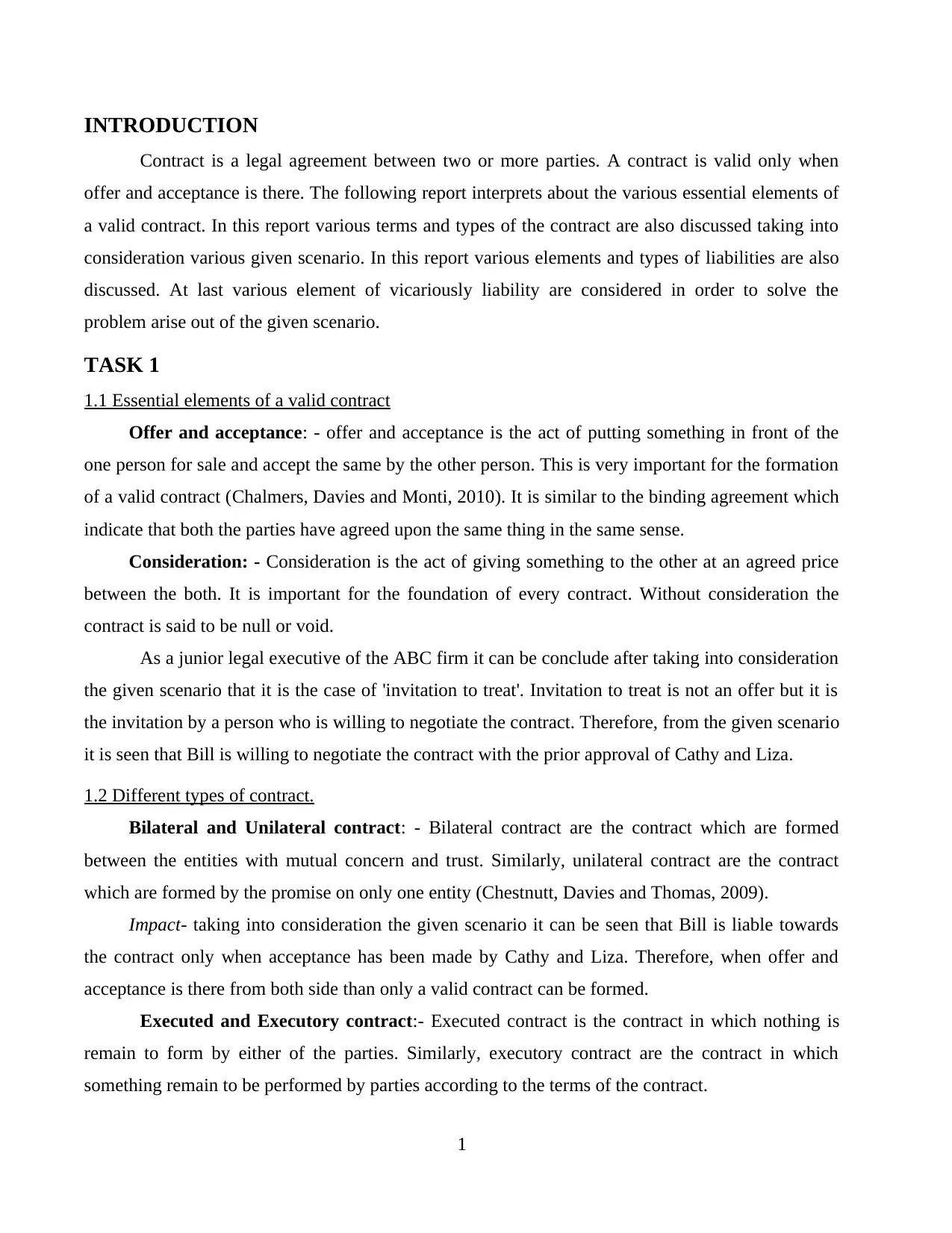
INTRODUCTION
Contract is a legal agreement between two or more parties. A contract is valid only when
offer and acceptance is there. The following report interprets about the various essential elements of
a valid contract. In this report various terms and types of the contract are also discussed taking into
consideration various given scenario. In this report various elements and types of liabilities are also
discussed. At last various element of vicariously liability are considered in order to solve the
problem arise out of the given scenario.
TASK 1
1.1 Essential elements of a valid contract
Offer and acceptance: - offer and acceptance is the act of putting something in front of the
one person for sale and accept the same by the other person. This is very important for the formation
of a valid contract (Chalmers, Davies and Monti, 2010). It is similar to the binding agreement which
indicate that both the parties have agreed upon the same thing in the same sense.
Consideration: - Consideration is the act of giving something to the other at an agreed price
between the both. It is important for the foundation of every contract. Without consideration the
contract is said to be null or void.
As a junior legal executive of the ABC firm it can be conclude after taking into consideration
the given scenario that it is the case of 'invitation to treat'. Invitation to treat is not an offer but it is
the invitation by a person who is willing to negotiate the contract. Therefore, from the given scenario
it is seen that Bill is willing to negotiate the contract with the prior approval of Cathy and Liza.
1.2 Different types of contract.
Bilateral and Unilateral contract: - Bilateral contract are the contract which are formed
between the entities with mutual concern and trust. Similarly, unilateral contract are the contract
which are formed by the promise on only one entity (Chestnutt, Davies and Thomas, 2009).
Impact- taking into consideration the given scenario it can be seen that Bill is liable towards
the contract only when acceptance has been made by Cathy and Liza. Therefore, when offer and
acceptance is there from both side than only a valid contract can be formed.
Executed and Executory contract:- Executed contract is the contract in which nothing is
remain to form by either of the parties. Similarly, executory contract are the contract in which
something remain to be performed by parties according to the terms of the contract.
1
Contract is a legal agreement between two or more parties. A contract is valid only when
offer and acceptance is there. The following report interprets about the various essential elements of
a valid contract. In this report various terms and types of the contract are also discussed taking into
consideration various given scenario. In this report various elements and types of liabilities are also
discussed. At last various element of vicariously liability are considered in order to solve the
problem arise out of the given scenario.
TASK 1
1.1 Essential elements of a valid contract
Offer and acceptance: - offer and acceptance is the act of putting something in front of the
one person for sale and accept the same by the other person. This is very important for the formation
of a valid contract (Chalmers, Davies and Monti, 2010). It is similar to the binding agreement which
indicate that both the parties have agreed upon the same thing in the same sense.
Consideration: - Consideration is the act of giving something to the other at an agreed price
between the both. It is important for the foundation of every contract. Without consideration the
contract is said to be null or void.
As a junior legal executive of the ABC firm it can be conclude after taking into consideration
the given scenario that it is the case of 'invitation to treat'. Invitation to treat is not an offer but it is
the invitation by a person who is willing to negotiate the contract. Therefore, from the given scenario
it is seen that Bill is willing to negotiate the contract with the prior approval of Cathy and Liza.
1.2 Different types of contract.
Bilateral and Unilateral contract: - Bilateral contract are the contract which are formed
between the entities with mutual concern and trust. Similarly, unilateral contract are the contract
which are formed by the promise on only one entity (Chestnutt, Davies and Thomas, 2009).
Impact- taking into consideration the given scenario it can be seen that Bill is liable towards
the contract only when acceptance has been made by Cathy and Liza. Therefore, when offer and
acceptance is there from both side than only a valid contract can be formed.
Executed and Executory contract:- Executed contract is the contract in which nothing is
remain to form by either of the parties. Similarly, executory contract are the contract in which
something remain to be performed by parties according to the terms of the contract.
1
⊘ This is a preview!⊘
Do you want full access?
Subscribe today to unlock all pages.

Trusted by 1+ million students worldwide
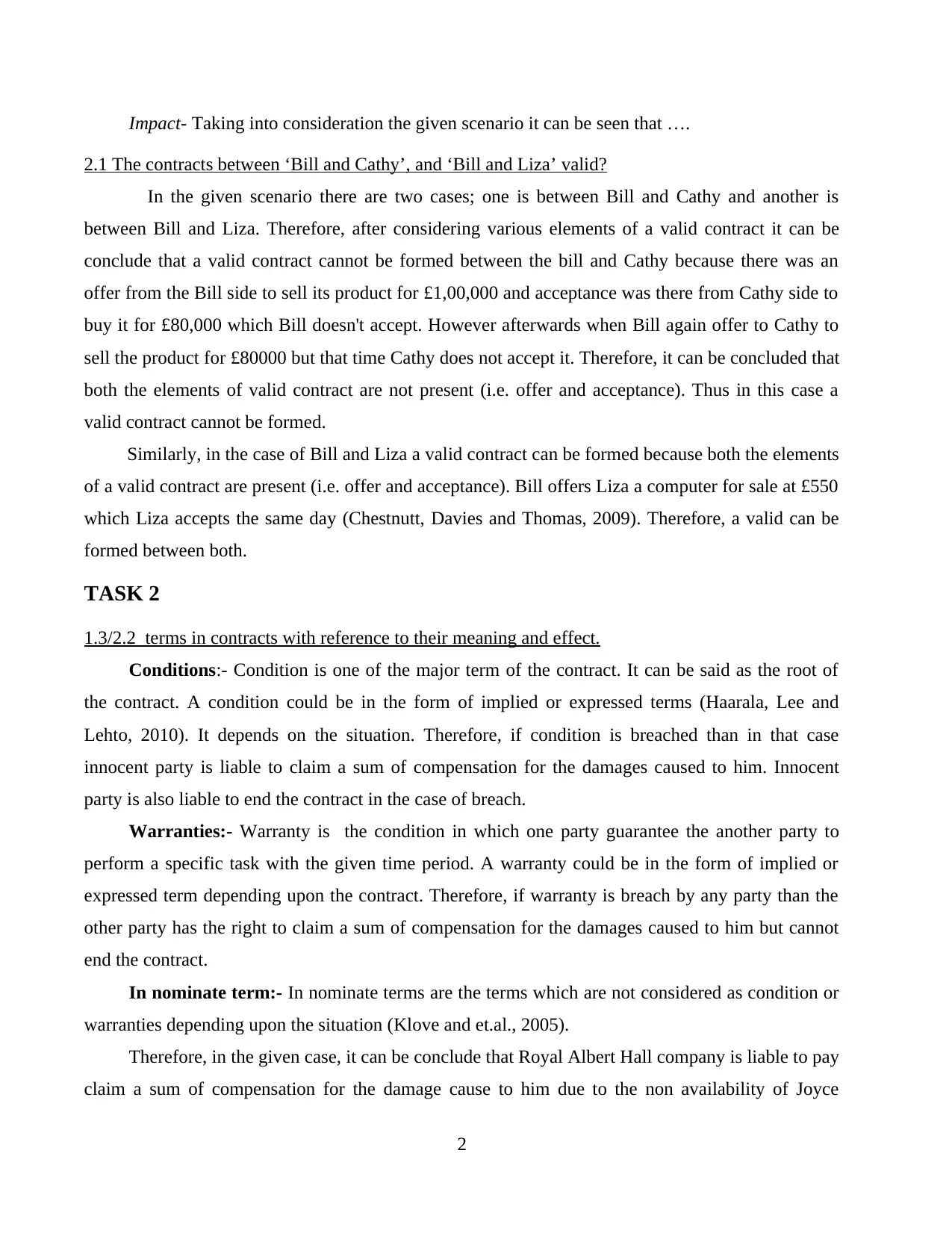
Impact- Taking into consideration the given scenario it can be seen that ….
2.1 The contracts between ‘Bill and Cathy’, and ‘Bill and Liza’ valid?
In the given scenario there are two cases; one is between Bill and Cathy and another is
between Bill and Liza. Therefore, after considering various elements of a valid contract it can be
conclude that a valid contract cannot be formed between the bill and Cathy because there was an
offer from the Bill side to sell its product for £1,00,000 and acceptance was there from Cathy side to
buy it for £80,000 which Bill doesn't accept. However afterwards when Bill again offer to Cathy to
sell the product for £80000 but that time Cathy does not accept it. Therefore, it can be concluded that
both the elements of valid contract are not present (i.e. offer and acceptance). Thus in this case a
valid contract cannot be formed.
Similarly, in the case of Bill and Liza a valid contract can be formed because both the elements
of a valid contract are present (i.e. offer and acceptance). Bill offers Liza a computer for sale at £550
which Liza accepts the same day (Chestnutt, Davies and Thomas, 2009). Therefore, a valid can be
formed between both.
TASK 2
1.3/2.2 terms in contracts with reference to their meaning and effect.
Conditions:- Condition is one of the major term of the contract. It can be said as the root of
the contract. A condition could be in the form of implied or expressed terms (Haarala, Lee and
Lehto, 2010). It depends on the situation. Therefore, if condition is breached than in that case
innocent party is liable to claim a sum of compensation for the damages caused to him. Innocent
party is also liable to end the contract in the case of breach.
Warranties:- Warranty is the condition in which one party guarantee the another party to
perform a specific task with the given time period. A warranty could be in the form of implied or
expressed term depending upon the contract. Therefore, if warranty is breach by any party than the
other party has the right to claim a sum of compensation for the damages caused to him but cannot
end the contract.
In nominate term:- In nominate terms are the terms which are not considered as condition or
warranties depending upon the situation (Klove and et.al., 2005).
Therefore, in the given case, it can be conclude that Royal Albert Hall company is liable to pay
claim a sum of compensation for the damage cause to him due to the non availability of Joyce
2
2.1 The contracts between ‘Bill and Cathy’, and ‘Bill and Liza’ valid?
In the given scenario there are two cases; one is between Bill and Cathy and another is
between Bill and Liza. Therefore, after considering various elements of a valid contract it can be
conclude that a valid contract cannot be formed between the bill and Cathy because there was an
offer from the Bill side to sell its product for £1,00,000 and acceptance was there from Cathy side to
buy it for £80,000 which Bill doesn't accept. However afterwards when Bill again offer to Cathy to
sell the product for £80000 but that time Cathy does not accept it. Therefore, it can be concluded that
both the elements of valid contract are not present (i.e. offer and acceptance). Thus in this case a
valid contract cannot be formed.
Similarly, in the case of Bill and Liza a valid contract can be formed because both the elements
of a valid contract are present (i.e. offer and acceptance). Bill offers Liza a computer for sale at £550
which Liza accepts the same day (Chestnutt, Davies and Thomas, 2009). Therefore, a valid can be
formed between both.
TASK 2
1.3/2.2 terms in contracts with reference to their meaning and effect.
Conditions:- Condition is one of the major term of the contract. It can be said as the root of
the contract. A condition could be in the form of implied or expressed terms (Haarala, Lee and
Lehto, 2010). It depends on the situation. Therefore, if condition is breached than in that case
innocent party is liable to claim a sum of compensation for the damages caused to him. Innocent
party is also liable to end the contract in the case of breach.
Warranties:- Warranty is the condition in which one party guarantee the another party to
perform a specific task with the given time period. A warranty could be in the form of implied or
expressed term depending upon the contract. Therefore, if warranty is breach by any party than the
other party has the right to claim a sum of compensation for the damages caused to him but cannot
end the contract.
In nominate term:- In nominate terms are the terms which are not considered as condition or
warranties depending upon the situation (Klove and et.al., 2005).
Therefore, in the given case, it can be conclude that Royal Albert Hall company is liable to pay
claim a sum of compensation for the damage cause to him due to the non availability of Joyce
2
Paraphrase This Document
Need a fresh take? Get an instant paraphrase of this document with our AI Paraphraser
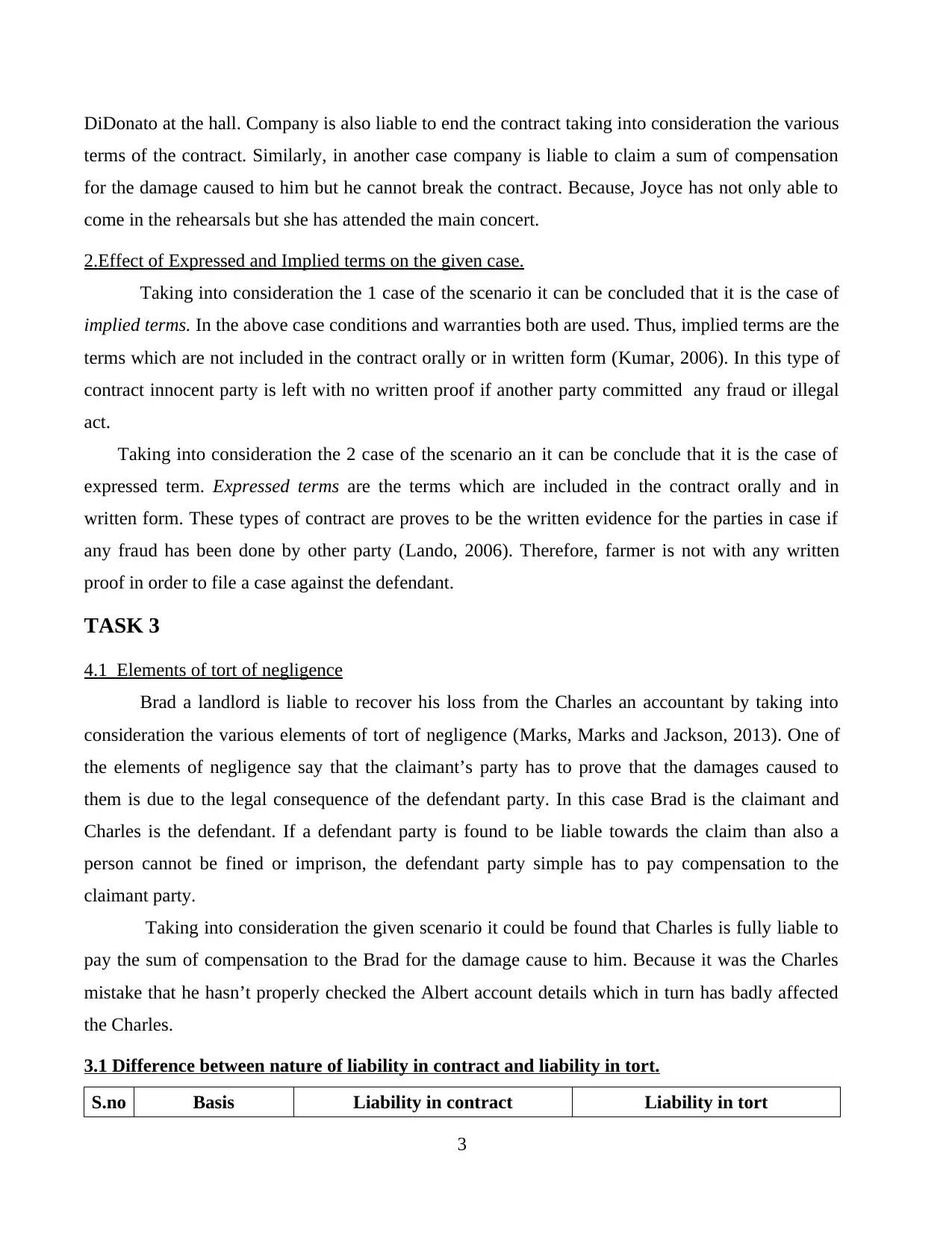
DiDonato at the hall. Company is also liable to end the contract taking into consideration the various
terms of the contract. Similarly, in another case company is liable to claim a sum of compensation
for the damage caused to him but he cannot break the contract. Because, Joyce has not only able to
come in the rehearsals but she has attended the main concert.
2.Effect of Expressed and Implied terms on the given case.
Taking into consideration the 1 case of the scenario it can be concluded that it is the case of
implied terms. In the above case conditions and warranties both are used. Thus, implied terms are the
terms which are not included in the contract orally or in written form (Kumar, 2006). In this type of
contract innocent party is left with no written proof if another party committed any fraud or illegal
act.
Taking into consideration the 2 case of the scenario an it can be conclude that it is the case of
expressed term. Expressed terms are the terms which are included in the contract orally and in
written form. These types of contract are proves to be the written evidence for the parties in case if
any fraud has been done by other party (Lando, 2006). Therefore, farmer is not with any written
proof in order to file a case against the defendant.
TASK 3
4.1 Elements of tort of negligence
Brad a landlord is liable to recover his loss from the Charles an accountant by taking into
consideration the various elements of tort of negligence (Marks, Marks and Jackson, 2013). One of
the elements of negligence say that the claimant’s party has to prove that the damages caused to
them is due to the legal consequence of the defendant party. In this case Brad is the claimant and
Charles is the defendant. If a defendant party is found to be liable towards the claim than also a
person cannot be fined or imprison, the defendant party simple has to pay compensation to the
claimant party.
Taking into consideration the given scenario it could be found that Charles is fully liable to
pay the sum of compensation to the Brad for the damage cause to him. Because it was the Charles
mistake that he hasn’t properly checked the Albert account details which in turn has badly affected
the Charles.
3.1 Difference between nature of liability in contract and liability in tort.
S.no Basis Liability in contract Liability in tort
3
terms of the contract. Similarly, in another case company is liable to claim a sum of compensation
for the damage caused to him but he cannot break the contract. Because, Joyce has not only able to
come in the rehearsals but she has attended the main concert.
2.Effect of Expressed and Implied terms on the given case.
Taking into consideration the 1 case of the scenario it can be concluded that it is the case of
implied terms. In the above case conditions and warranties both are used. Thus, implied terms are the
terms which are not included in the contract orally or in written form (Kumar, 2006). In this type of
contract innocent party is left with no written proof if another party committed any fraud or illegal
act.
Taking into consideration the 2 case of the scenario an it can be conclude that it is the case of
expressed term. Expressed terms are the terms which are included in the contract orally and in
written form. These types of contract are proves to be the written evidence for the parties in case if
any fraud has been done by other party (Lando, 2006). Therefore, farmer is not with any written
proof in order to file a case against the defendant.
TASK 3
4.1 Elements of tort of negligence
Brad a landlord is liable to recover his loss from the Charles an accountant by taking into
consideration the various elements of tort of negligence (Marks, Marks and Jackson, 2013). One of
the elements of negligence say that the claimant’s party has to prove that the damages caused to
them is due to the legal consequence of the defendant party. In this case Brad is the claimant and
Charles is the defendant. If a defendant party is found to be liable towards the claim than also a
person cannot be fined or imprison, the defendant party simple has to pay compensation to the
claimant party.
Taking into consideration the given scenario it could be found that Charles is fully liable to
pay the sum of compensation to the Brad for the damage cause to him. Because it was the Charles
mistake that he hasn’t properly checked the Albert account details which in turn has badly affected
the Charles.
3.1 Difference between nature of liability in contract and liability in tort.
S.no Basis Liability in contract Liability in tort
3
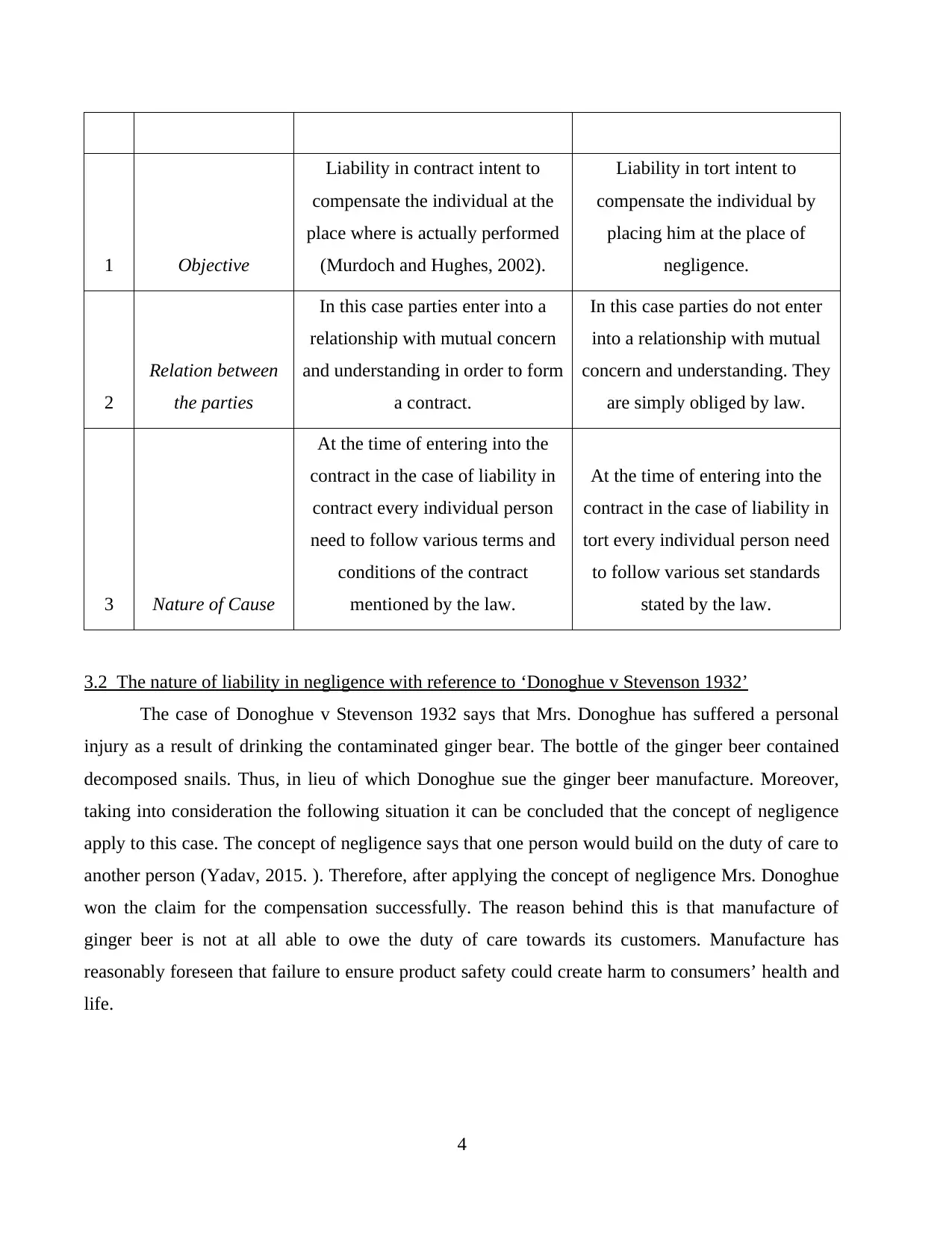
1 Objective
Liability in contract intent to
compensate the individual at the
place where is actually performed
(Murdoch and Hughes, 2002).
Liability in tort intent to
compensate the individual by
placing him at the place of
negligence.
2
Relation between
the parties
In this case parties enter into a
relationship with mutual concern
and understanding in order to form
a contract.
In this case parties do not enter
into a relationship with mutual
concern and understanding. They
are simply obliged by law.
3 Nature of Cause
At the time of entering into the
contract in the case of liability in
contract every individual person
need to follow various terms and
conditions of the contract
mentioned by the law.
At the time of entering into the
contract in the case of liability in
tort every individual person need
to follow various set standards
stated by the law.
3.2 The nature of liability in negligence with reference to ‘Donoghue v Stevenson 1932’
The case of Donoghue v Stevenson 1932 says that Mrs. Donoghue has suffered a personal
injury as a result of drinking the contaminated ginger bear. The bottle of the ginger beer contained
decomposed snails. Thus, in lieu of which Donoghue sue the ginger beer manufacture. Moreover,
taking into consideration the following situation it can be concluded that the concept of negligence
apply to this case. The concept of negligence says that one person would build on the duty of care to
another person (Yadav, 2015. ). Therefore, after applying the concept of negligence Mrs. Donoghue
won the claim for the compensation successfully. The reason behind this is that manufacture of
ginger beer is not at all able to owe the duty of care towards its customers. Manufacture has
reasonably foreseen that failure to ensure product safety could create harm to consumers’ health and
life.
4
Liability in contract intent to
compensate the individual at the
place where is actually performed
(Murdoch and Hughes, 2002).
Liability in tort intent to
compensate the individual by
placing him at the place of
negligence.
2
Relation between
the parties
In this case parties enter into a
relationship with mutual concern
and understanding in order to form
a contract.
In this case parties do not enter
into a relationship with mutual
concern and understanding. They
are simply obliged by law.
3 Nature of Cause
At the time of entering into the
contract in the case of liability in
contract every individual person
need to follow various terms and
conditions of the contract
mentioned by the law.
At the time of entering into the
contract in the case of liability in
tort every individual person need
to follow various set standards
stated by the law.
3.2 The nature of liability in negligence with reference to ‘Donoghue v Stevenson 1932’
The case of Donoghue v Stevenson 1932 says that Mrs. Donoghue has suffered a personal
injury as a result of drinking the contaminated ginger bear. The bottle of the ginger beer contained
decomposed snails. Thus, in lieu of which Donoghue sue the ginger beer manufacture. Moreover,
taking into consideration the following situation it can be concluded that the concept of negligence
apply to this case. The concept of negligence says that one person would build on the duty of care to
another person (Yadav, 2015. ). Therefore, after applying the concept of negligence Mrs. Donoghue
won the claim for the compensation successfully. The reason behind this is that manufacture of
ginger beer is not at all able to owe the duty of care towards its customers. Manufacture has
reasonably foreseen that failure to ensure product safety could create harm to consumers’ health and
life.
4
⊘ This is a preview!⊘
Do you want full access?
Subscribe today to unlock all pages.

Trusted by 1+ million students worldwide
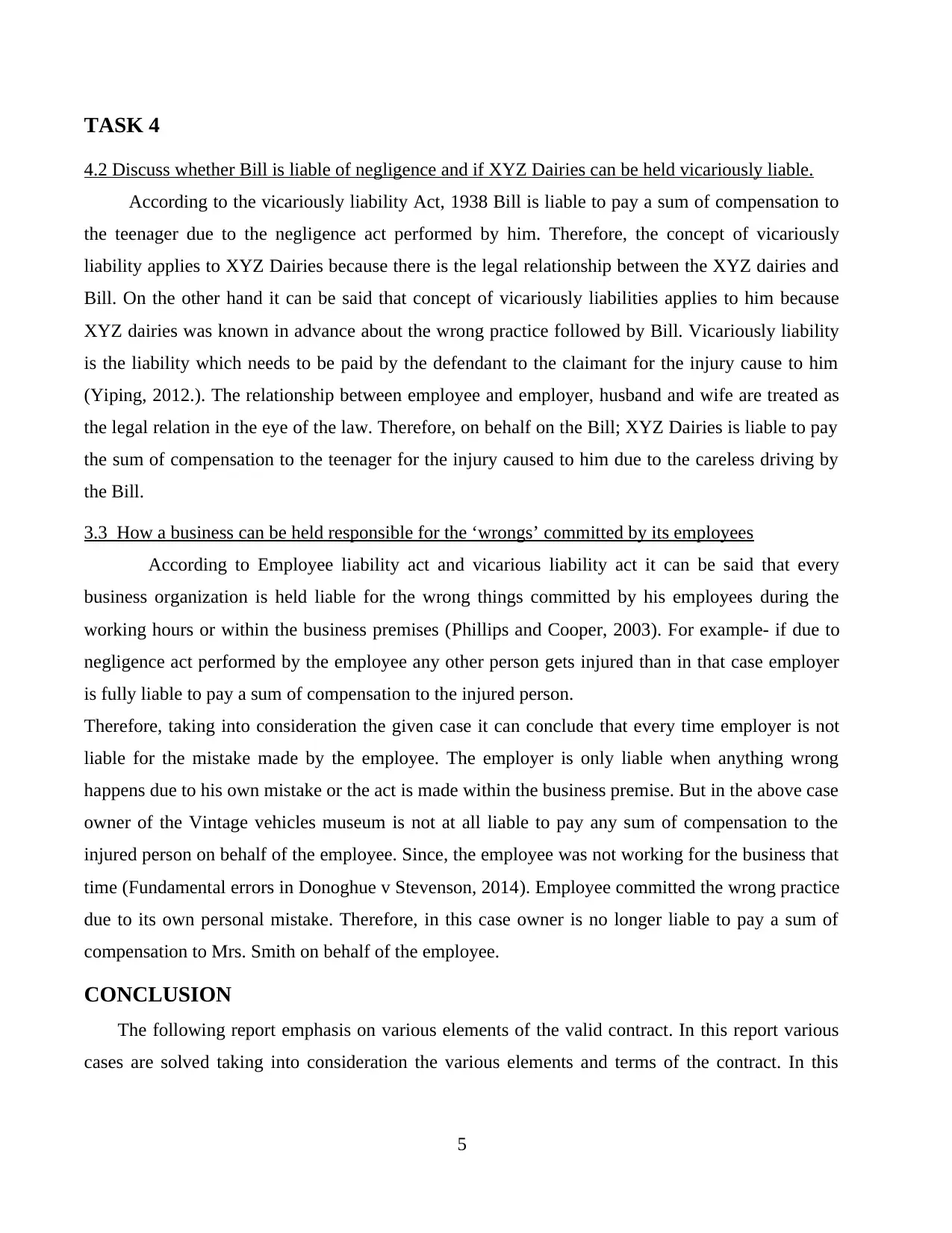
TASK 4
4.2 Discuss whether Bill is liable of negligence and if XYZ Dairies can be held vicariously liable.
According to the vicariously liability Act, 1938 Bill is liable to pay a sum of compensation to
the teenager due to the negligence act performed by him. Therefore, the concept of vicariously
liability applies to XYZ Dairies because there is the legal relationship between the XYZ dairies and
Bill. On the other hand it can be said that concept of vicariously liabilities applies to him because
XYZ dairies was known in advance about the wrong practice followed by Bill. Vicariously liability
is the liability which needs to be paid by the defendant to the claimant for the injury cause to him
(Yiping, 2012.). The relationship between employee and employer, husband and wife are treated as
the legal relation in the eye of the law. Therefore, on behalf on the Bill; XYZ Dairies is liable to pay
the sum of compensation to the teenager for the injury caused to him due to the careless driving by
the Bill.
3.3 How a business can be held responsible for the ‘wrongs’ committed by its employees
According to Employee liability act and vicarious liability act it can be said that every
business organization is held liable for the wrong things committed by his employees during the
working hours or within the business premises (Phillips and Cooper, 2003). For example- if due to
negligence act performed by the employee any other person gets injured than in that case employer
is fully liable to pay a sum of compensation to the injured person.
Therefore, taking into consideration the given case it can conclude that every time employer is not
liable for the mistake made by the employee. The employer is only liable when anything wrong
happens due to his own mistake or the act is made within the business premise. But in the above case
owner of the Vintage vehicles museum is not at all liable to pay any sum of compensation to the
injured person on behalf of the employee. Since, the employee was not working for the business that
time (Fundamental errors in Donoghue v Stevenson, 2014). Employee committed the wrong practice
due to its own personal mistake. Therefore, in this case owner is no longer liable to pay a sum of
compensation to Mrs. Smith on behalf of the employee.
CONCLUSION
The following report emphasis on various elements of the valid contract. In this report various
cases are solved taking into consideration the various elements and terms of the contract. In this
5
4.2 Discuss whether Bill is liable of negligence and if XYZ Dairies can be held vicariously liable.
According to the vicariously liability Act, 1938 Bill is liable to pay a sum of compensation to
the teenager due to the negligence act performed by him. Therefore, the concept of vicariously
liability applies to XYZ Dairies because there is the legal relationship between the XYZ dairies and
Bill. On the other hand it can be said that concept of vicariously liabilities applies to him because
XYZ dairies was known in advance about the wrong practice followed by Bill. Vicariously liability
is the liability which needs to be paid by the defendant to the claimant for the injury cause to him
(Yiping, 2012.). The relationship between employee and employer, husband and wife are treated as
the legal relation in the eye of the law. Therefore, on behalf on the Bill; XYZ Dairies is liable to pay
the sum of compensation to the teenager for the injury caused to him due to the careless driving by
the Bill.
3.3 How a business can be held responsible for the ‘wrongs’ committed by its employees
According to Employee liability act and vicarious liability act it can be said that every
business organization is held liable for the wrong things committed by his employees during the
working hours or within the business premises (Phillips and Cooper, 2003). For example- if due to
negligence act performed by the employee any other person gets injured than in that case employer
is fully liable to pay a sum of compensation to the injured person.
Therefore, taking into consideration the given case it can conclude that every time employer is not
liable for the mistake made by the employee. The employer is only liable when anything wrong
happens due to his own mistake or the act is made within the business premise. But in the above case
owner of the Vintage vehicles museum is not at all liable to pay any sum of compensation to the
injured person on behalf of the employee. Since, the employee was not working for the business that
time (Fundamental errors in Donoghue v Stevenson, 2014). Employee committed the wrong practice
due to its own personal mistake. Therefore, in this case owner is no longer liable to pay a sum of
compensation to Mrs. Smith on behalf of the employee.
CONCLUSION
The following report emphasis on various elements of the valid contract. In this report various
cases are solved taking into consideration the various elements and terms of the contract. In this
5
Paraphrase This Document
Need a fresh take? Get an instant paraphrase of this document with our AI Paraphraser
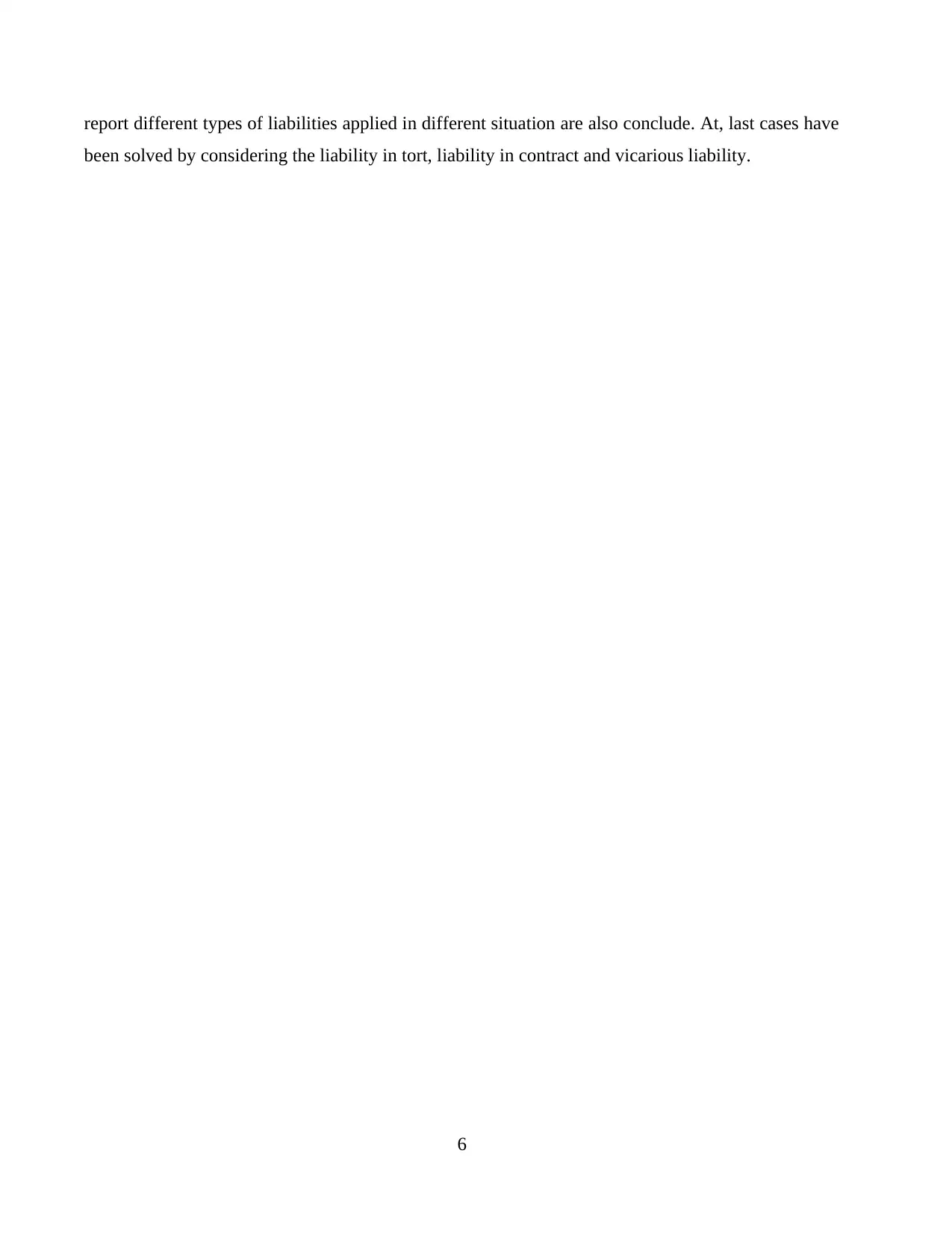
report different types of liabilities applied in different situation are also conclude. At, last cases have
been solved by considering the liability in tort, liability in contract and vicarious liability.
6
been solved by considering the liability in tort, liability in contract and vicarious liability.
6
1 out of 8
Related Documents
Your All-in-One AI-Powered Toolkit for Academic Success.
+13062052269
info@desklib.com
Available 24*7 on WhatsApp / Email
![[object Object]](/_next/static/media/star-bottom.7253800d.svg)
Unlock your academic potential
Copyright © 2020–2025 A2Z Services. All Rights Reserved. Developed and managed by ZUCOL.




![Analysis of Contract and Tort Law in Business Context - [Module Name]](/_next/image/?url=https%3A%2F%2Fdesklib.com%2Fmedia%2Fimages%2Fb4a2ce2d00e84688b846acd1edfd5492.jpg&w=256&q=75)
